Best Practice for Your Shopify Jewellery Store
If you’re an ecommerce jeweller looking to elevate your online presence, then look no further. Using our experience working with jewellery brands across the globe, we’ve put together a guide to help you craft and refine an exquisite Shopify jewellery store that dazzles customers, inspires confidence and boosts conversions.
Written By
Hannah Smiddy

Valued at $28.68bn USD in 2022, the global online jewellery market is poised to more than double by 2027 to $58.9bn USD.1 With such significant growth predicted, this is a sector brimming with opportunity. Optimising your Shopify jewellery store to capitalise on this opportunity should be a top priority.
That said, competition is fierce. It’s the brands who can create dazzling online experiences and forge meaningful relationships with their customers that will be successful in winning clicks, conversions and loyalty.
There are a number of complexities surrounding jewellery ecommerce that make it a tricky sector to succeed in. It can be difficult to showcase intricate details of items and convey their quality online. What’s more, when it comes to high-ticket, high-consideration pieces, customers are accustomed to handling and examining these in-store before committing to a purchase decision.
This article explores best practices for your Shopify Plus jewellery store that will help you differentiate your brand from the competition and create immersive customer experiences that bridge the gap between online and offline commerce.
It features several examples from global jewellery clients Swanky has worked with, as well as other leading brands in the industry.
We also reference technology partners whose solutions allow online jewellery retailers to create best-in-class digital experiences.
12 tips for selling jewellery online
1. Leverage impactful lifestyle imagery and video content
As online shoppers aren’t able to physically touch your jewellery products, it’s important to create an immersive experience that aligns with the emotive, meaningful nature of your offering. The goal is to show customers that your product complements their lifestyle.
One way you can do this is with lifestyle photographs that capture your product in a true-to-life setting. These sorts of images tell the story of your brand and its values. They invite shoppers to imagine themselves (or a gift recipient) wearing the jewellery – connecting with customers on an emotional level and creating a sense of desire. They also give shoppers the confidence they need to convert by helping them visualise key product attributes in a real-life context.
You can leverage lifestyle images across your Shopify jewellery store, creating impactful touch points throughout the customer journey:
- Using a lifestyle photograph as your homepage hero image is a great way to instantly add important context about your brand and start stirring feelings of desire.
- Leveraging lifestyle imagery on your landing pages supports visual storytelling and communicates important information about your brand and demographic. This is a common way to create impact and encourage users to stay on your online store.
- Weaving lifestyle photographs throughout your product pages adds important visual context for consumers and educates them on the features and value of your jewellery pieces.
Lifestyle imagery played a central role when we redesigned British brand Daisy’s ecommerce jewellery store. We leveraged their stunning photography within an image-centric navigation menu, which served to inspire users on their product discovery journey.
Meanwhile, we maximised image sizes on product and collection pages to showcase the beautiful detail of Daisy’s jewellery. You can read more about our use of lifestyle imagery in this case study about migrating Daisy from Magento to Shopify Plus.
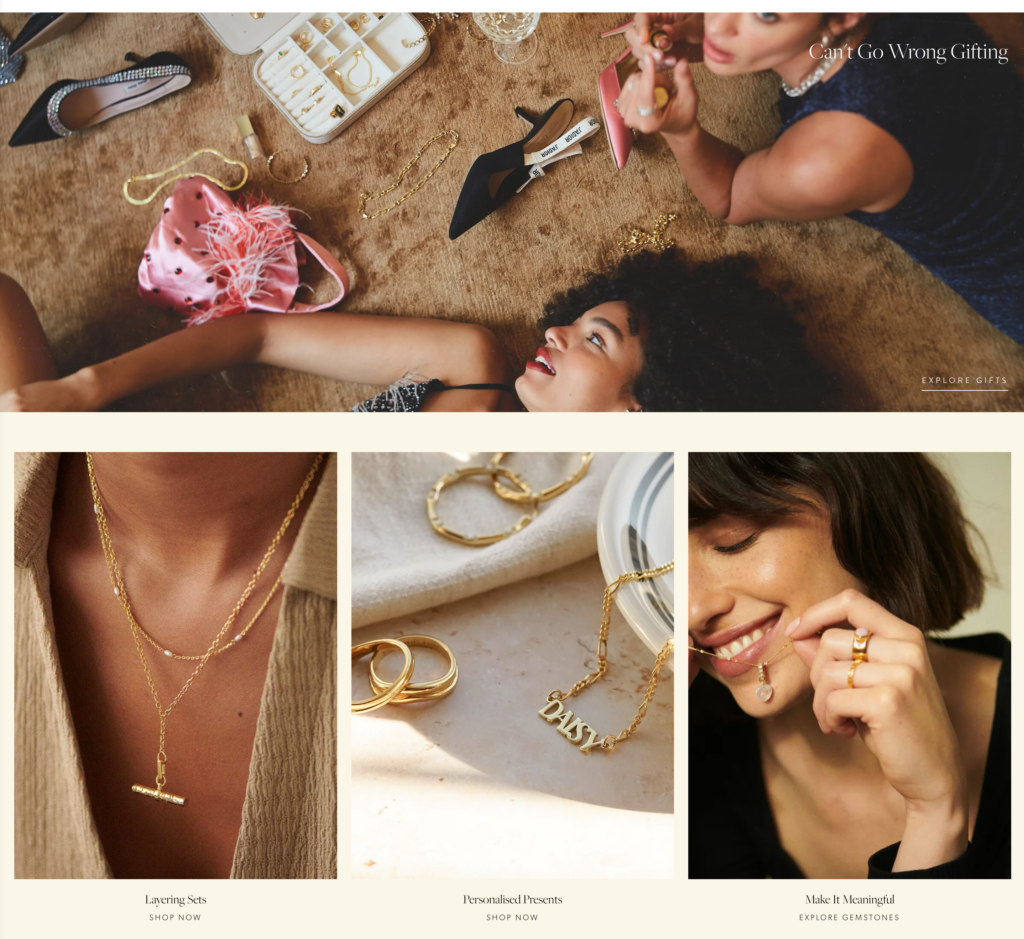
Daisy also make use of video content to capture attention and evoke feelings of aspiration – elevating the browsing experience to another level.
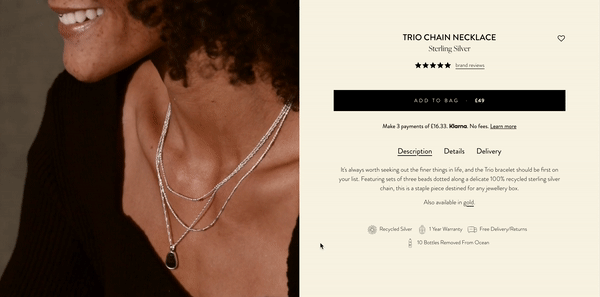
2. Showcase pieces with high-quality product photography
Complement your aspirational lifestyle imagery with high-quality product photographs. These images should be crisp, clear and consistently styled to communicate credibility and trustworthiness.
Purchasing jewellery typically requires significant consideration, especially when it’s done online. With this in mind, it’s crucial to allow shoppers to fully explore your product with a gallery of photographs shot from every angle.
You should also consider experimenting with 360-degree rotating images that enable consumers to closely inspect jewellery pieces.
And, to properly showcase the intricate details of your jewellery products, experiment with close-up shots and zoom functionality.
Get your product photography right, and your images will capture attention, increase perceived value and boost consumer confidence. This translates to increased sales and higher customer satisfaction.
3. Offer virtual try-on functionality
Why not go one step further than photography and video content, experimenting with virtual try-on augmented reality (AR) technology on your product pages? AR is bridging the gap between physical and digital commerce, fast becoming a mainstream feature on jewellery ecommerce websites as brands compete for customers and conversions.
This sort of experiential functionality allows shoppers to ‘try on’ jewellery before they commit to a purchase. Consumers can easily assess key aspects of a jewellery item, like colour, stone size and chain drop for instance, and even compare multiple items.
Popular British jewellery chain H. Samuel offers AR functionality as part of the user experience on their ecommerce website.
Customers shopping for rings can select the “Virtual Try-On” option on product pages, take a photo of their hand, and then watch as the ring of interest is superimposed on their finger. Users can even drag and drop the ring to position it on a different finger.
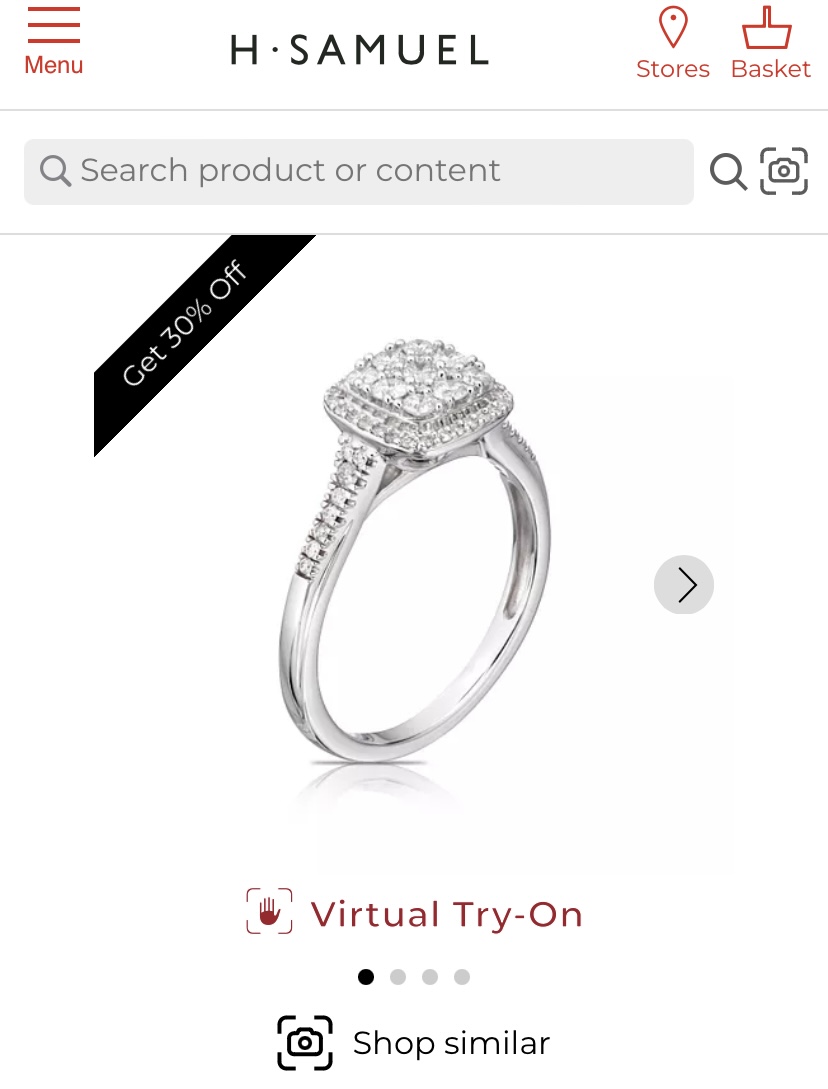
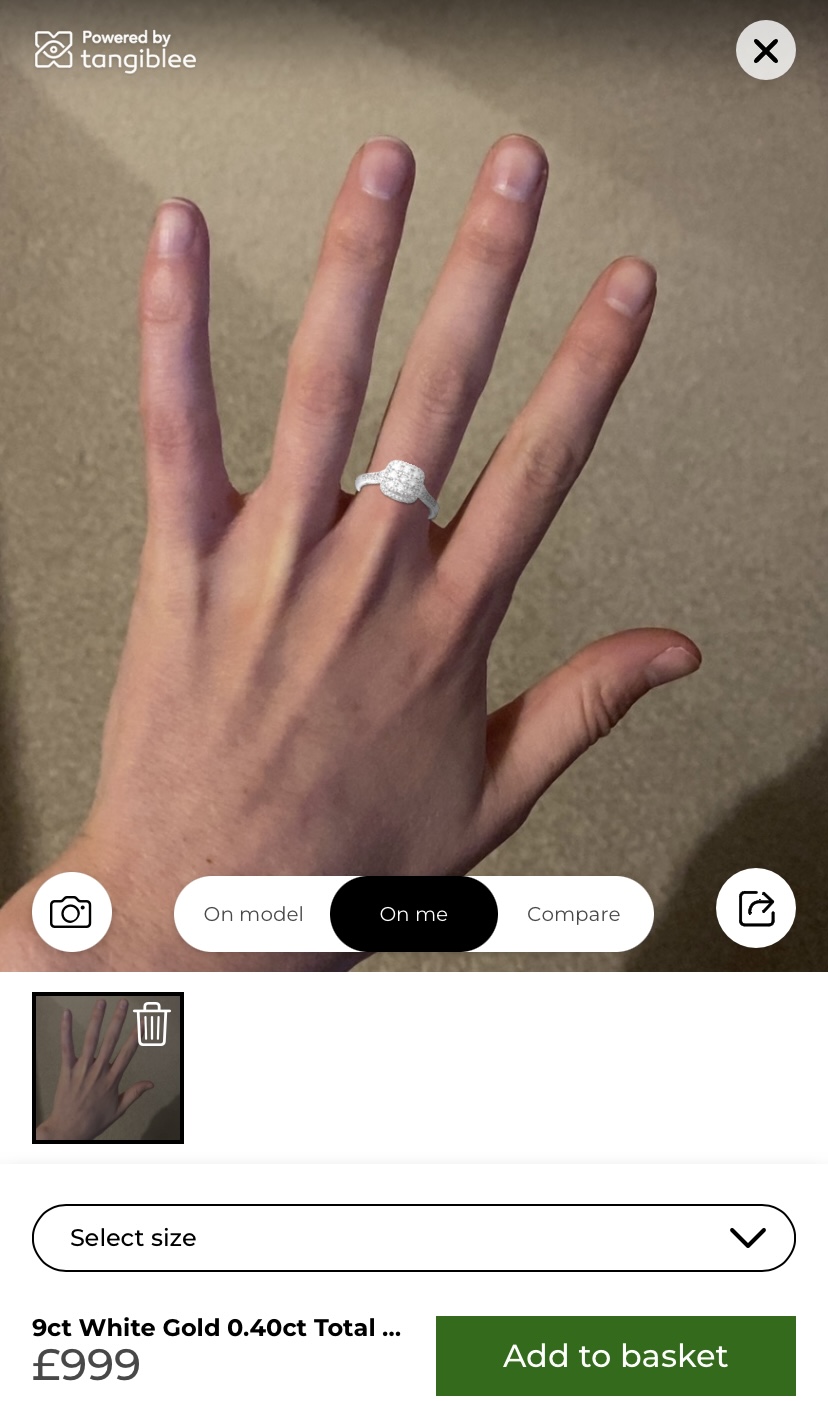
Embracing this technology can help remove a lot of the uncertainty that often surrounds online shopping, whilst making your customers’ experience more engaging. As a result, it can increase buyer confidence, boost conversion rate and reduce returns.
We talk more about the advantages offered by this technology in our article on the benefits of AR for fashion ecommerce.
4. Help users pick the right size item
You may not be selling clothing or footwear, but it’s important not to overlook the importance of product sizing in jewellery ecommerce. Customers might not necessarily know what their ring size is or what necklace length suits them, and these aspects can be difficult to understand when shopping online. Not providing guidance or tools to help them could cause frustrated customers to browse elsewhere.
Include a size chart on your product pages, as well as linking through to a more detailed sizing guide. Ultimately, the more assistance you can provide, the more likely someone is to complete a purchase.
Shopify Plus jewellery retailer Astrid & Miyu provide a great example of this in action. Customers can view the below size chart when selecting a size in the product page:
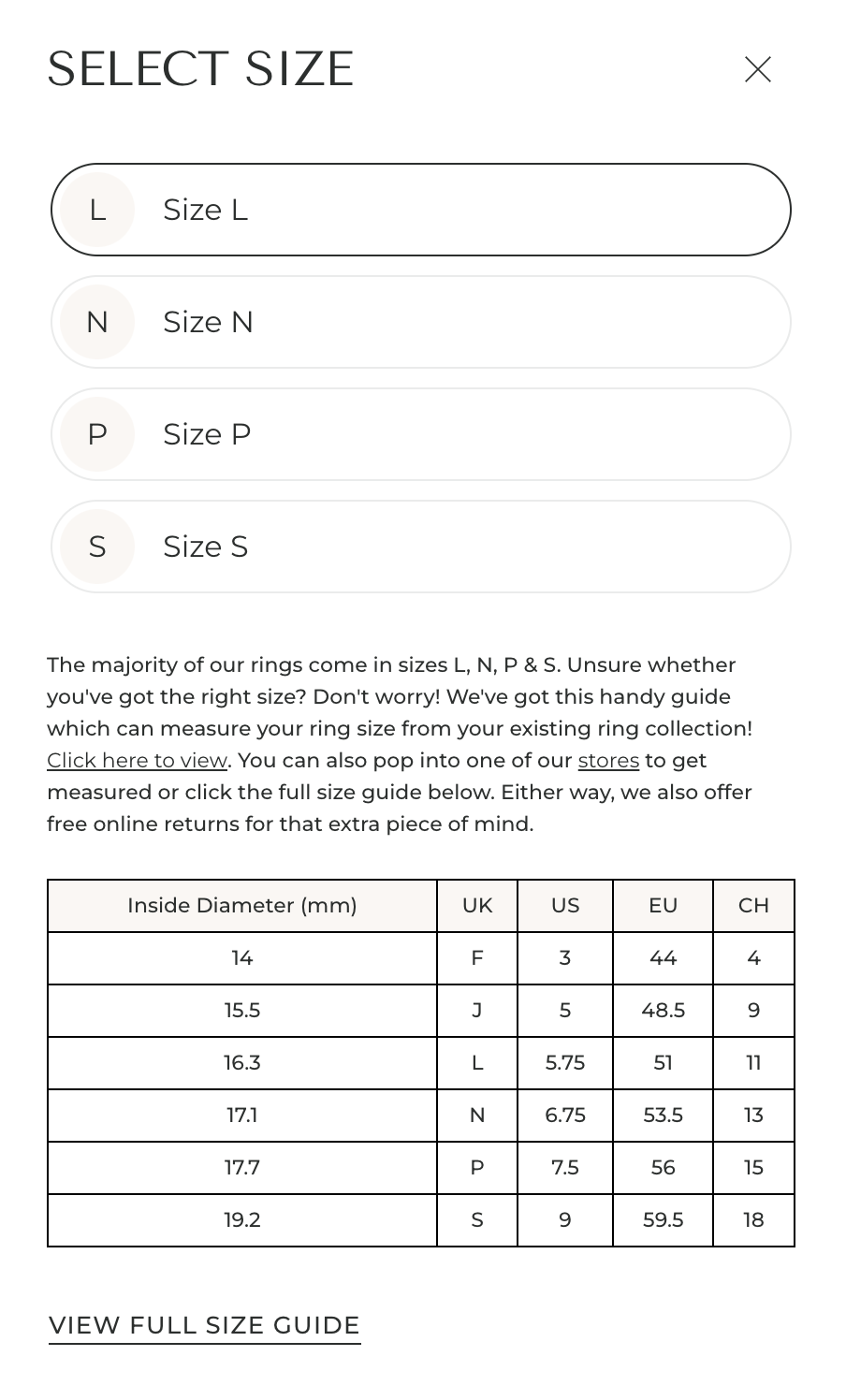
Or, shoppers can choose to explore the full size guide if they wish:
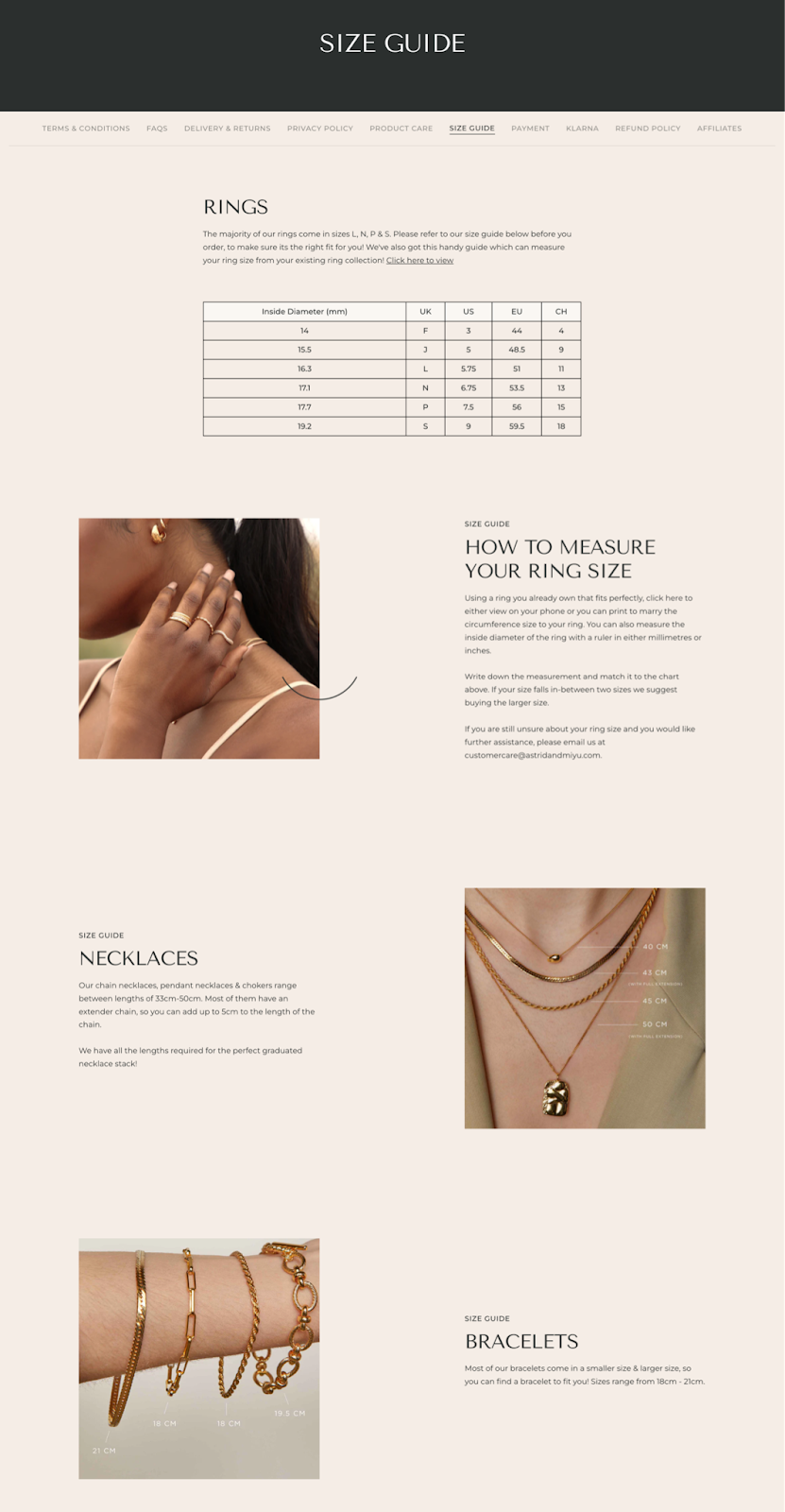
Shopify merchants have access to multiple size guide apps at their fingertips, but one that we leverage here at Swanky is Kiwi Size Guide. With its size recommendation tool and sizing charts, it helps customers quickly and easily pick the right size for them – increasing customer satisfaction, boosting conversions and reducing returns.
5. Allow users to filter products for streamlined product discovery
With so many options available, shopping for jewellery online can sometimes be overwhelming for consumers.
One way you can help visitors find the product they want as smoothly as possible is by implementing filtering functionality on your Shopify jewellery store. Allow users to filter collections and search results by things like price, product type, metal, gemstone and chain length.
Specific filters for gifting can also be useful for shoppers, including those that sort products by gift recipient (e.g. for him, for her, girlfriend, mother), occasion (e.g. wedding, anniversary, birthday) and price (e.g. under £20, under £50). We talk more about the importance of filters for gift-givers in the next section.
McKinney’s Jewellers – one of Australia’s most prestigious jewellers and Swanky client – leverage Smart Search & Filter from Searchanise to do this on their Shopify ecommerce store.

The ability to narrow down products based on their own purchase criteria is important for reducing shoppers’ cognitive load, increasing their satisfaction and facilitating a smooth path to purchase. Plus, if customers have a positive experience on your online jewellery store, they’re more likely to recommend your brand to someone else.
6. Focus on gift-givers
For Nichola Birch, Product Manager at Swanky, one of her biggest tips for online jewellery retailers is to focus on gifting.
“As an ecommerce jewellery retailer, a significant segment of your audience will likely be gift-givers. Curating a clear and intuitive user journey for these consumers is key.
“This journey should begin with a ‘gifts’ navigation item and specific collections for gifts such as ‘Gifts under £X’, ‘Gifts for Him’, as well as filters on collection and search results pages.
“Once they’ve found the perfect present, gifters want to know that it’s going to look nice when it arrives with the recipient. Adding images of your gift packaging to your product page is a must. Then consider other gift options like gift wrapping, or gift messaging in the cart.”
Daisy Jewellery offer complimentary gift wrapping and personalised gift notes to elevate the gifting experience. They showcase this prominently on their product page:
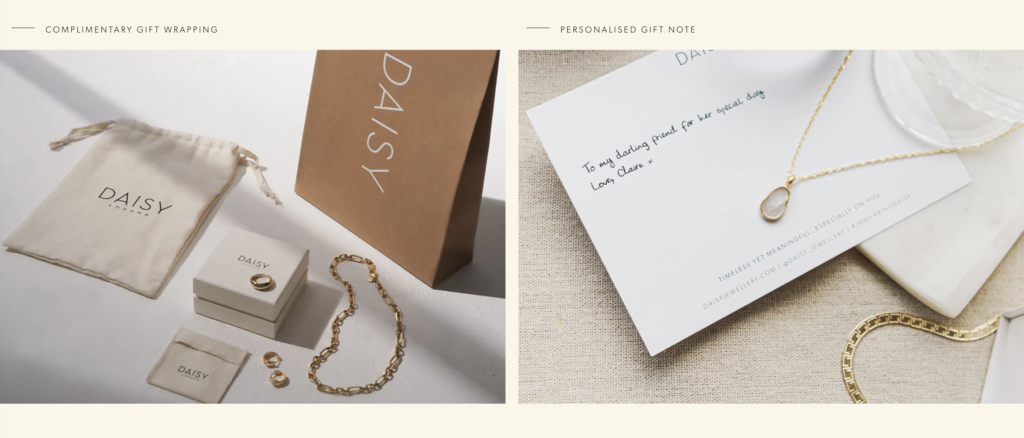
It’s also important to think about the two different types of gifters and how you can appeal to their needs.
So-called “get in and get out” gifters want a quick, simple and convenient online shopping experience. Make it as easy as possible for them to find a suitable gift through streamlined product discovery, clear navigation and helpful filtering.
Considered gifters, on the other hand, tend to browse for longer and typically try to match the jewellery’s meaning to their gift recipient. Some of the things we talk about in this article are particularly important for creating an engaging experience for these gifters, including immersive visual content, detailed FAQs and inspirational social proof.
“Online jewellery merchants need to consider both types of gifters to excel. Get this right and gift-givers will give you the gift of free promotion. Recipients may not have heard of you before, but this jewellery present could be the first step of a loyal relationship with your brand,” comments Nichola.
7. Unlock the power of social proof on your jewellery ecommerce store
As with selling any product online, social proof elements such as reviews, customer photos and star ratings can be a powerful influence on prospective customers. We get a sense of empowerment when presented with insights from our peers and naturally trust their reviews of a product or a brand.
Knowing that someone else has had a positive experience with a company and rates the quality of a product highly can unlock shoppers’ confidence and nudge them closer to the checkout. This is especially true of high consideration purchases like jewellery, often being bought as a gift for a special occasion.
Given the impact of social proof, it’s wise to integrate this across your jewellery ecommerce store, at various touch points in the customer journey. For example, displaying a star rating above the fold on your homepage instantly signals credibility to users, whilst placing reviews on product pages adds an important layer of trustworthiness to your site.
Jewellery brand Daisy use Yotpo, another Swanky favourite, to capture and showcase customer reviews on their product pages:
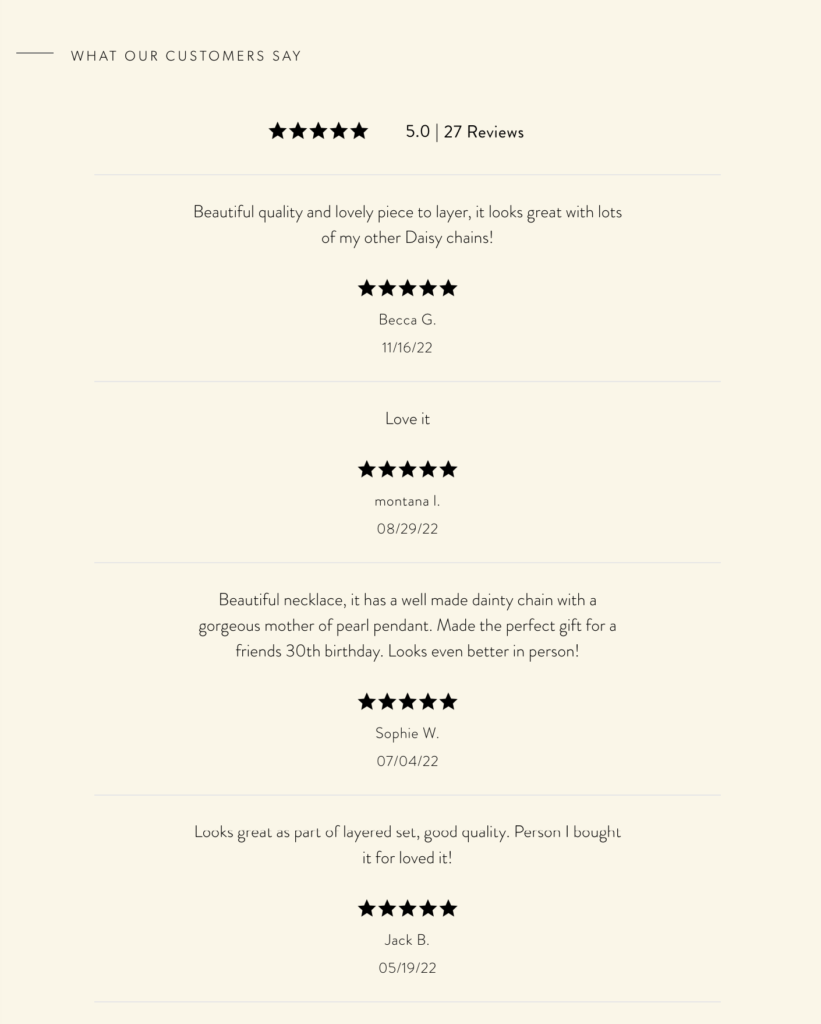
You can also leverage social proof by embedding your Instagram feed onto your ecommerce store, or displaying user images. Seeing authentic photos of real-life customers wearing your jewellery pieces can add credibility, provide inspiration and increase sales.
Brooklyn-based jewellery brand Ana Luisa do just this on their Shopify jewellery store, with customer photos integrated on their product pages for shoppers to “get inspired”. These are placed just above written reviews – a double whammy for social proof!
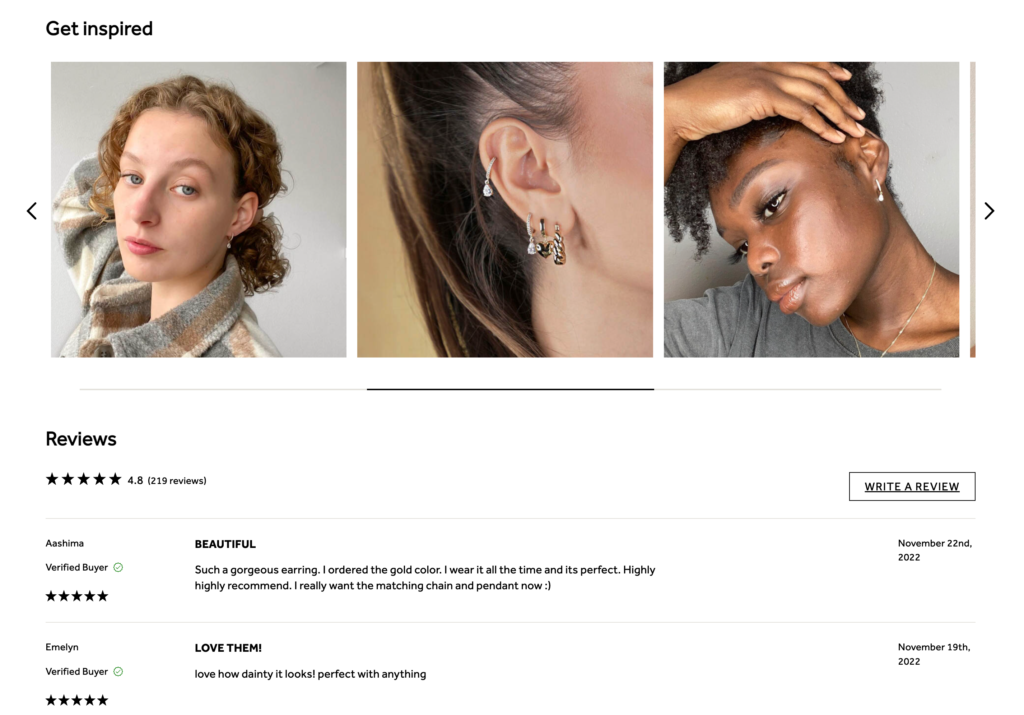
8. Cross-sell matching items to increase AOV
With matching products often available, DTC jewellery ecommerce lends itself perfectly to cross-selling – especially with the trend of stacking or layering jewellery. You can recommend complementary products on your product pages, helping to elevate the overall shopping experience for your customers whilst increasing average order value (AOV) and revenue.
For inspiration, look to international contemporary jewellery brand Missoma, who’ve implemented a “Get the look” feature on product pages.
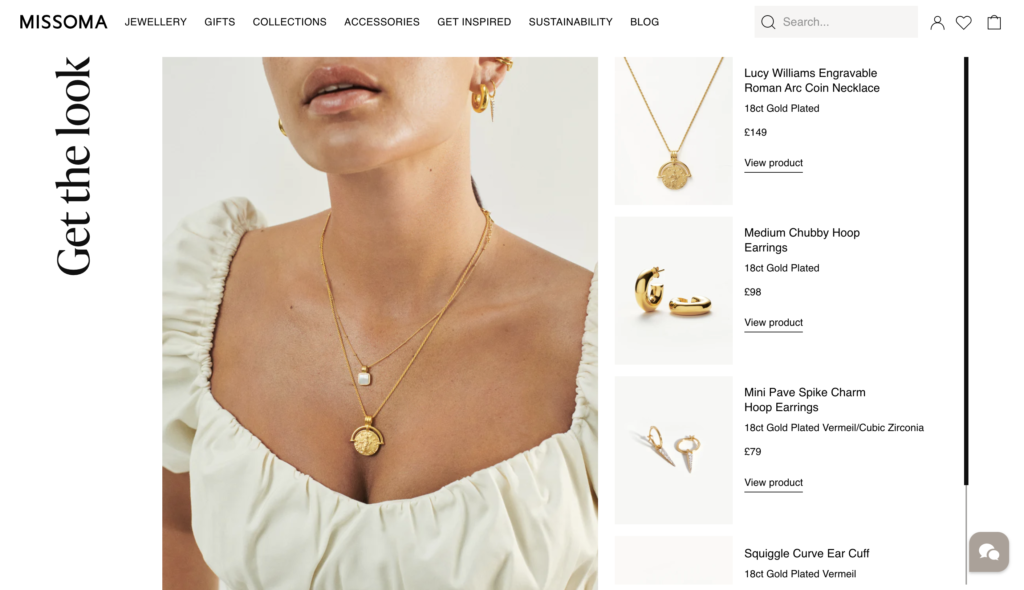
Cross-selling isn’t just limited to product pages though – you can also suggest matching items in the cart and allow shoppers to effortlessly add them with just one click.
You may even want to implement a product bundling strategy. This popular cross-selling tactic involves packaging complementary products as a set of items to be purchased together, often at a discount. It’s a strategy proven to increase sales, boost AOV and aid product discovery.
9. Provide inspiration and advice on your blog
Your Shopify jewellery store blog should be a place of inspiration and advice; a hub of styling tips and how-tos. Throughout your blog you want to provide your customers with a memorable narrative that they’ll associate with your brand and products.
Consider the following ideas for providing engaging and useful content:
- Help readers stay up to date with current jewellery trends. Which materials, colours and styles are “en vogue”? Demonstrate your knowledge and position yourself as a go-to authority.
- Produce style guides with helpful tips on how to wear your pieces. Can they be stacked or layered? What sort of outfit would complement the pieces in your latest collection? Take a visual approach to this with inspiration galleries.
- Create gift guides that streamline the product discovery process for shoppers.
- Share care guides packed full of advice on how to properly look after your jewellery.
- Go behind the scenes and share stories of how your products are made. This will satisfy consumers’ increasing curiosity around the origins of the things they buy. This is a great opportunity to feature video content too – perfect for humanising your brand and increasing engagement.
- Choose content themes that align with your audience’s wider interests. For example, Australian pure play ecommerce brand and Swanky client Medley Jewellery cover topics such as fashion, nail art and self-care on their blog, along with plenty of articles on jewellery trends, cleaning hacks and styling tips.
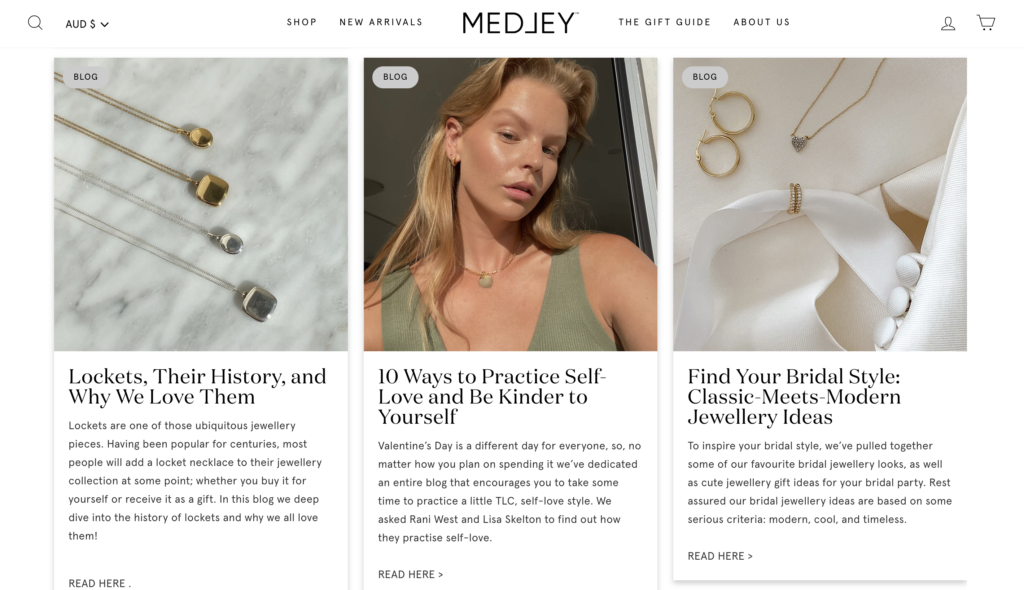
Providing value like this is a proven strategy for positioning yourself as an industry leader, building trust in your brand and nurturing meaningful relationships with customers. Furthermore, creating relevant, keyword-optimised blog posts can increase your visibility on search results, helping to attract new shoppers to your brand.
You can learn more about these perks in our article on the benefits of content marketing for ecommerce brands.
10. Build a knowledge hub with FAQs
Shoppers may have questions beyond the details communicated in your product descriptions, particularly around things like ring sizing, jewellery care and return policies. Without a sales assistant present like in brick-and-mortar stores, your ability to provide advice and answers is imperative – and will say a lot about your brand and its attitude towards customers.
By anticipating common questions and providing answers on an easily-accessible FAQ page, you can make life easier for both your customers and your support team – all whilst protecting your margins.
A detailed knowledge hub helps customers make informed purchase decisions, which can reduce the need for costly returns and restocking. Having FAQs already answered means shoppers can find the answers they need themselves, without needing to contact your team.
What’s more, this is a great way to establish trust with shoppers and demonstrate that you have considered their needs.
Make sure your FAQ page is easy to find, with a spot in your website’s navigation bar or footer links.
Beyond providing FAQs, it could be worth exploring the benefits of live chat and automated customer support. We talk more about the characteristics of good ecommerce customer service on our blog.
11. Differentiate your brand with loyalty incentives
It’s not uncommon for shoppers to compare items and prices across different jewellery brands – after all, jewellery is typically a high-consideration purchase. One way to differentiate your brand from competitors is to offer compelling loyalty incentives to shoppers.
The promise of increasingly attractive perks in each loyalty program tier will not only spur new customers to make a purchase for the first time, it’ll encourage existing customers to come back and make subsequent purchases. A loyalty program is therefore a great way to boost retention and reduce customer acquisition cost.
Popular loyalty perks include free shipping, discounts, VIP sale access and exclusive gifts. You can gift shoppers these rewards for each purchase they make, as well as for on-site actions like submitting a review, uploading a photo or referring a friend.
Singaporean jewellery brand and Swanky client By Invite Only use LoyaltyLion to power their loyalty program, “Crystal Club”. Shoppers can earn points for activities across the site and then redeem these for discount vouchers.
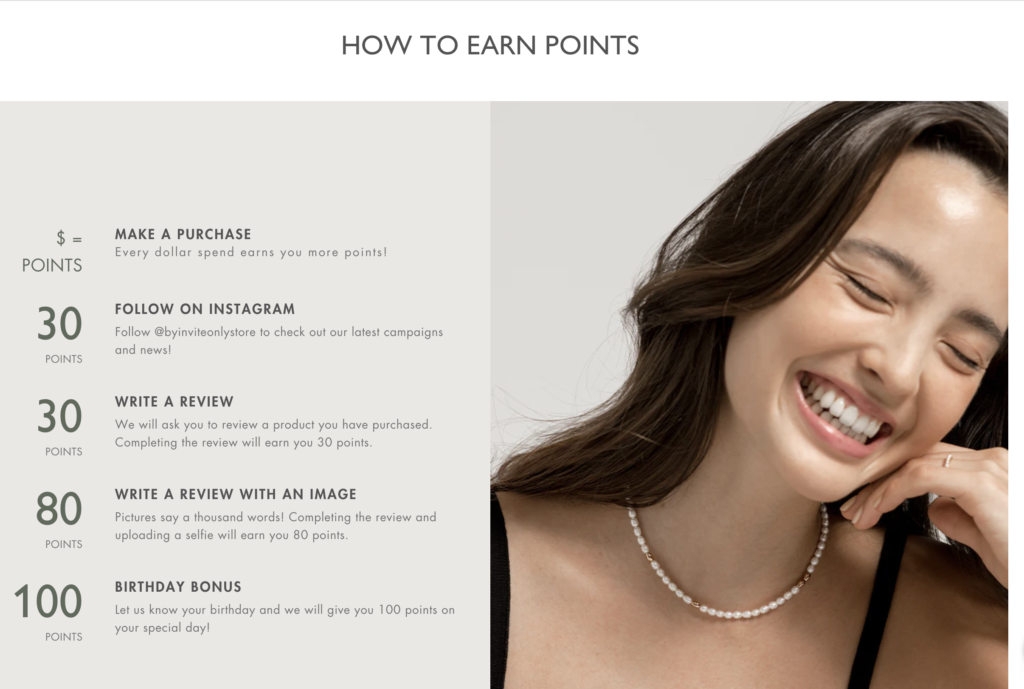
Note how customers are rewarded with more points for uploading reviews with images – this can be a very effective strategy for driving the production of user generated content, which, as we explored earlier, can be leveraged to build trust with new shoppers.
12. Collaborate with relevant influencers in your niche
With an increasing number of merchants now selling jewellery online, one way to increase awareness of your brand and rapidly build trust with your audience is to collaborate with relevant influencers.
Partnering with micro-influencers who have between 10k and 100k followers can be particularly effective (rather than teaming up with macro-influencers). This is because product recommendations from these individuals are often seen as more authentic and reliable. It’s also important to collaborate with influencers who clearly align with your brand’s values.
British demi-fine jewellery retailer Monica Vinader is an example of a brand doing this well. Their partnership with influencer Jelena Weir saw an engagement rate of 3x the industry average, which has been credited to her active affiliation with the company’s sustainable and ethical values.2
You can learn more about the perks of collaborating with micro-influencers in our guide to the benefits of influencer marketing.
Creating a successful Shopify jewellery store: A final word
There are a number of strategies and solutions you can deploy on your quest to distinguish your brand as the ultimate destination for online jewellery shoppers.
Using the best practices we’ve explored in this article, and by leveraging Shopify Plus’ powerful integrations, you can create an immersive online experience that transcends the transactional, inspires confidence in committing to a purchase, and nurtures meaningful connections with loyal customers.
We build exquisite jewellery websites on Shopify Plus
Over the years, Swanky has had the privilege to work with several ambitious jewellery brands across the globe, creating beautiful Shopify Plus stores that inspire clicks, conversions and loyalty. Our international portfolio of jewellery website design and development includes UK brands Daisy and W.Bruford and APAC companies Medley, McKinneys and By Invite Only.
Working with these brands to bring their ecommerce visions to life, we’ve learnt lots about jewellery consumers’ needs, preferences, motivations and behaviours. And, as this article demonstrates, we know our stuff about what makes a successful Shopify jewellery store.
To find out how Swanky can help your jewellery brand unlock its ecommerce potential, get in touch with our friendly team of Shopify Plus Experts.
For reference:
[1] https://www.statista.com/statistics/1201073/online-jewelry-market-value-worldwide/
[2] https://www.wearisma.com/2021/02/18/deep-dive-analysis-into-5-top-jewellery-brands-influencer-share-of-voice/

